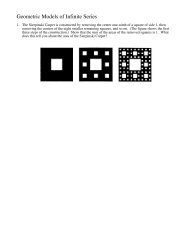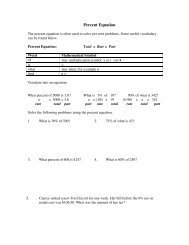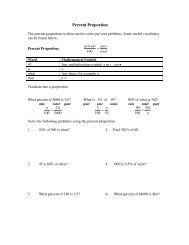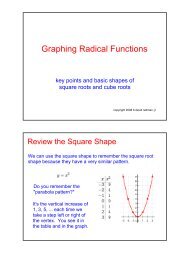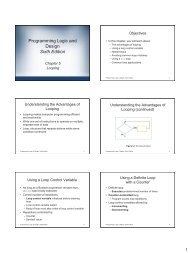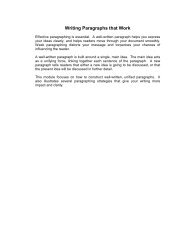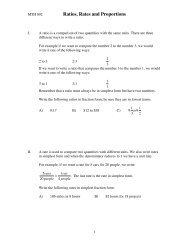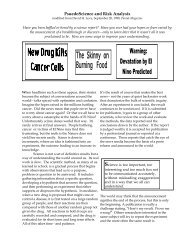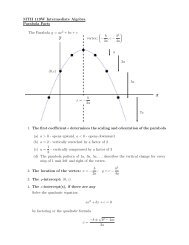MTH 260 SECTION 3.4 27 DELTA COLLEGE Let S be the subset of ...
MTH 260 SECTION 3.4 27 DELTA COLLEGE Let S be the subset of ...
MTH 260 SECTION 3.4 27 DELTA COLLEGE Let S be the subset of ...
Create successful ePaper yourself
Turn your PDF publications into a flip-book with our unique Google optimized e-Paper software.
<strong>MTH</strong> <strong>260</strong> <strong>SECTION</strong> <strong>3.4</strong> <strong>27</strong><br />
<strong>DELTA</strong> <strong>COLLEGE</strong><br />
<strong>Let</strong> S <strong>be</strong> <strong>the</strong> <strong>subset</strong> <strong>of</strong> ordered pairs <strong>of</strong> integers defined recursively by<br />
Basis step: (0, 0) ∈ S.<br />
Recursive step: If (a, b) ∈ S, <strong>the</strong>n (a, b + 1) ∈ S, (a + 1, b + 1) ∈ S, and (a + 2, b + 1) ∈ S.<br />
a) List <strong>the</strong> elements <strong>of</strong> S produced by <strong>the</strong> first four applications <strong>of</strong> <strong>the</strong> recursive definition.<br />
b) Use strong induction on <strong>the</strong> num<strong>be</strong>r <strong>of</strong> applications <strong>of</strong> <strong>the</strong> recursive step <strong>of</strong> <strong>the</strong> definition<br />
to show that a ≤ 2b whenever (a, b) ∈ S.<br />
c) Use structural induction to show that a ≤ 2b whenever (a, b) ∈ S.<br />
Solution<br />
a) After <strong>the</strong> basis step:<br />
After <strong>the</strong> first recursive step:<br />
S = {(0, 0)}<br />
S = {(0, 0),<br />
(0, 1), (1, 1), (2, 1)}<br />
After <strong>the</strong> second recursive step:<br />
S = {(0, 0),<br />
(0, 1), (1, 1), (2, 1),<br />
(0, 2), (1, 2), (2, 2), (3, 2), (4, 2)}<br />
After <strong>the</strong> third recursive step:<br />
S = {(0, 0),<br />
(0, 1), (1, 1), (2, 1),<br />
(0, 2), (1, 2), (2, 2), (3, 2), (4, 2),<br />
(0, 3), (1, 3), (2, 3), (3, 3), (4, 3), (5, 3), (6, 3)}<br />
After <strong>the</strong> fourth recursive step:<br />
S = {(0, 0),<br />
(0, 1), (1, 1), (2, 1),<br />
(0, 2), (1, 2), (2, 2), (3, 2), (4, 2),<br />
(0, 3), (1, 3), (2, 3), (3, 3), (4, 3), (5, 3), (6, 3),<br />
(0, 4), (1, 4), (2, 4), (3, 4), (4, 4), (5, 4), (6, 4), (7, 4), (8, 4)}
Think <strong>of</strong> <strong>the</strong> points <strong>of</strong> S <strong>be</strong>ing generated on a grid and you will have a good picture <strong>of</strong> <strong>the</strong><br />
points generated after each step.<br />
b) Using strong induction on <strong>the</strong> num<strong>be</strong>r n <strong>of</strong> applications <strong>of</strong> <strong>the</strong> recursive step, where n is<br />
a non-negative integer, let P (n) <strong>be</strong> <strong>the</strong> statement:<br />
“After n applications <strong>of</strong> <strong>the</strong> recursive step, a ≤ 2b whenever (a, b) ∈ S.”<br />
The statement P (0) is true, since after 0 applications <strong>of</strong> <strong>the</strong> recursive step <strong>the</strong> only mem<strong>be</strong>r<br />
<strong>of</strong> S is (0, 0) and 0 ≤ 2(0).<br />
Now assume that <strong>the</strong> statements P (j) are true for 0 ≤ j ≤ k and show that P (k + 1) is true.<br />
Take a mem<strong>be</strong>r (a, b) <strong>of</strong> S that has <strong>be</strong>en generated after k + 1 applications <strong>of</strong> <strong>the</strong> recursive<br />
step. If (a, b) occured after j applications <strong>of</strong> <strong>the</strong> recursive step, and j ≤ k, <strong>the</strong>n we know that<br />
a ≤ 2b by assumption. If (a, b) occured only after k + 1 applications <strong>of</strong> <strong>the</strong> recursive step <strong>the</strong>n<br />
<strong>the</strong>re is a mem<strong>be</strong>r (α, β) ∈ S, generated after fewer applications <strong>of</strong> <strong>the</strong> recursive step, such that<br />
(a, b) is ei<strong>the</strong>r<br />
(α, β + 1), (α + 1, β + 1), or (α + 2, β + 1)<br />
For each <strong>of</strong> <strong>the</strong>se three possibilities a ≤ 2b <strong>be</strong>cause α ≤ 2β (by assumption):<br />
i) For <strong>the</strong> first pair: a = α ≤ 2β < 2(β + 1) = 2b.<br />
ii) For <strong>the</strong> second pair: a = α + 1 ≤ 2β + 1 < 2(β + 1) = 2b.<br />
iii) For <strong>the</strong> third pair: a = α + 2 ≤ 2β + 2 = 2(β + 1) = 2b.<br />
Therefore P (k + 1) is true and P (n) is true for all non-negative integers n.<br />
c) Now using structural induction we prove <strong>the</strong> statment:<br />
“a ≤ 2b whenever (a, b) ∈ S.”<br />
In <strong>the</strong> basis step <strong>of</strong> <strong>the</strong> recursive definition (0, 0) is <strong>the</strong> only mem<strong>be</strong>r <strong>of</strong> S and 0 ≤ 2(0).<br />
In <strong>the</strong> recursive step we generate a new element (a, b) <strong>of</strong> S from an existing element (α, β) ∈ S<br />
in one <strong>of</strong> three ways:<br />
(α, β + 1), (α + 1, β + 1), or (α + 2, β + 1)<br />
By assumption α ≤ 2β, and in each <strong>of</strong> <strong>the</strong> three cases above, that guarentees that a ≤ 2b<br />
i) For <strong>the</strong> first pair: a = α ≤ 2β < 2(β + 1) = 2b.<br />
ii) For <strong>the</strong> second pair: a = α + 1 ≤ 2β + 1 < 2(β + 1) = 2b.<br />
iii) For <strong>the</strong> third pair: a = α + 2 ≤ 2β + 2 = 2(β + 1) = 2b.<br />
Therefore a ≤ 2b whenever (a, b) ∈ S.<br />
Notice that <strong>the</strong> two arguments are very similar, but <strong>the</strong> structural induction argument avoids<br />
<strong>the</strong> awkward reference to <strong>the</strong> num<strong>be</strong>r <strong>of</strong> applications <strong>of</strong> <strong>the</strong> recursive step.



